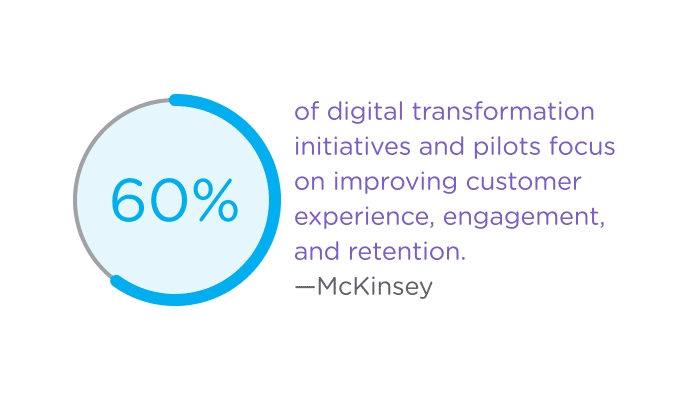A Guide to Digital Transformation
A Digital Transformation strategy is essential to your business, brands who do it well will excel, and those who stay status quo will become obsolete.


Defining the next generation of Customer Experience
Digital experiences are all around us. Whether it’s clipping grocery coupons from an app, ordering furniture online to be picked up in-store, or submitting an insurance claim through text messages, the way that consumers communicate with brands is evolving at a rapid pace.
However, digital transformation is quite an elusive concept. Customers’ needs and expectations are continually changing. Therefore, digital transformation is an ever-evolving process, not a one-time action. It’s not enough to simply add a technology. There must be a cohesive strategy that guides the changes and sets a brand on a path to success.
Exploring digital transformation takes time and expertise. We’ve put together resources to help you dive deeper into the strategy, actions, and best practices for effective digital transformation initiatives.
What is digital transformation?
Digital transformation is the action of leveraging technology to optimize business processes. In other words, it’s about bringing everyday tasks, both for a business and its customers, to the digital world. There are many examples of digital transformation; from Intelligent Virtual Assistants improving customer experience to paperless billing and online shopping. And while this may seem straightforward, there are many hurdles that burden a company from achieving successful digital transformation.
Perhaps the most ubiquitous downfall of digital transformation is the implementation of technology without a long-term view. When new technologies enter the market, innovative enterprises often look to implement without an understanding of how the technology will be able to integrate with existing processes and work for them in the future. This leads to disjointed experiences across different technologies, often leaving employees and customers frustrated.
Even the best digital transformation will always require adapting and fine-tuning, but it will also be able to support a business in the long-run, and not need an overhaul every year. To learn more about undertaking digital transformation for the long haul, check out our ebook of how to future-proof your contact center.


How can digital transformation improve customer experience?
Customer experience is often the first place that businesses chose to implement digital transformation initiatives. Why? For starters, improving customer experience through more digital channels and processes can have a major impact on sales, revenue, and customer retention. And when strategically approached, technology in the contact center can have a major impact on reducing operational expenses.
Digital transformation is all about restructuring how and where a business meets its customers in order to fit the needs of the digital first age. Customer-facing technology, like a virtual assistant powered by Conversational AI, therefore is a great place to start. According to McKinsey, more than 60% of digital transformation initiatives and pilots focus on improving customer experience, engagement, and retention.
Where do you start with digital transformation?
Taking the first step is often the hardest part. Because digital transformation can be achieved through many different means, it’s important to first have a vision for how your business will define success in digital transformation. Prosperous initiatives often start with a cross-departmental team who leads the project. Include members from across the organization to ensure that the goals and methods will be integrated on the backend, which translates to a seamless experience for customers.
For example, if a contact center was implementing a new technology to enable more self-service options for customers, but did not have the input from the finance or security team from the beginning, they may not end up with a solution that provides secure payment methods to customers. To ensure the voice of every department is heard, collaborate from the start.
Once a team and strategy are put into place, it’s time to look at the most important aspect: the customers. Evaluating the customer journey gives a deep understanding of the state of customer experience, and where the first move should be. Check out our resources on customer journey mapping for more.
After these steps, brands should begin looking for a partnership with a managed service provider to assist them with all stages of the technology implementation. Especially when it comes to Conversational AI, domain knowledge and expertise is vital to a successful digital transformation.
It’s also important that the AI partner that you work with is at the forefront of innovation in the space. Evaluate the vendor’s background to see if their technology is something they believe at their core, or if it’s just an ad-hoc project that may or may not be a priority in the future. For example, if you are implementing AI- enabled customer care, make sure you find a partner whose mission is focused on AI and has a track record of constantly innovating in that area.

Digital transformation is not revolutionary, it’s evolutionary
Taking on digital transformation can feel daunting, but if you break it down into small steps, you can build a strategy that will not only support your short-term, but also your long-term goals. Businesses who use Conversational AI, specifically Intelligent Virtual Assistants (IVA), are seeing an immediate impact, both in improving customer experience and reducing costs. To ensure these results, it is important to find the right partner by looking at their full offering, pricing, and experience. Remember, digital transformation is a journey, not a one-and-done type of project. It requires constant measuring, adjustments, and growth to stay optimized and relevant.
As consumer demands and technological advancements evolve, brands must be focused on upleveling their capabilities to stay one step ahead. Offering cohesive, brand-aligned, effortless solutions, companies will see results not only in customer experience, but also in agent experience, revenue, customer loyalty and more traditional contact center metrics like average handling time (AHT), customer satisfaction (CSAT), and first call resolution (FCR).



